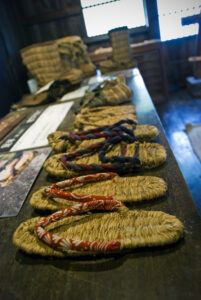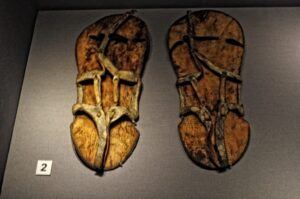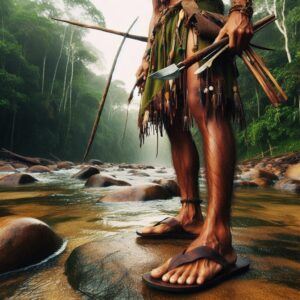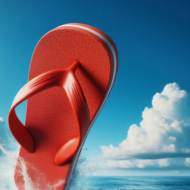FLIP FLOPS–A Living History
Flips flops are the most popular form of footwear today. Historically, they have helped carry people and their feet forward in real and gritty lives for a long time. Something that has been around for centuries naturally surfaces in our stories, art, politics, sports, and culture. It’s good to know where we came from and where we are going. Want to talk history!
First There Were Dinosaurs

I can hear my history teachers, (YAWN, feigned or real?), every school year, beginning at the Beginning. Darkness, Crawling out of the Water (depending on the story and culture), and then … Light! As for creatures walking the earth, Well. First, there were dinosaurs. (Again, depending on the story.) And then there was the lovely Lucy, the 3-4 million-year old, three and a half foot tall, humanoid and her many friends and family there in the Great Rift Valley of Ethiopia. Lucy’s remains are in a secure vault in the basement of the National Museum of Ethiopia in Addis Ababa. A replica is on the first floor for public viewing. There are also 3.5 million year-old footprints of bipeds from near Laetoli in Tanzania. In any case, for our topic, here, it must be said, there are no signs that Lucy was wearing flip flops.
Japanese Tradition

Let’s run the clock up to our human history. We understand the Japanese have been using different forms of the backless sandals for two thousand years or more. Theirs is a rich and storied and artistic tradition including both informal and formal styles made of rice straw matting, tied with cloth or twisted straw bands. Hemp was also applied for both soles and tie on’s. Too, wood was sometimes used, such as with the geisha clog. The slip-on was of course worn for daily work and life, including the labor-intensive farming of water-laden rice paddies.
Walk Like an Egyptian
More broadly, archaeologists find the flip flop in other parts of Asia and the Mediterranean regions, including Egypt. Egypt has the oldest dig of flip flops, 3200 years old (see photo). These and other digs evidence the use often of leather for soles.

The Twentieth Century, a Flip and a Flop?
What about these days? Now. When did modernity, the modern age, or at least contemporary times, begin for the flip flop? When did more cultures, beyond Asia, the Mediterranean, and Africa, discover them and begin using them? When did they become so popular around the entire world, in most countries and cultures? The great expansion of the flip flop dynasties is a post-WW II phenomenon as soldiers of many countries returned to their homes, sometimes with their Japanese, Indian, Philippine, and North African flip flops as well the appreciation and the custom of using them. I am certain returning soldiers brought much more home; and certainly they left much behind. These were the soldiers of Australia, New Zealand, Brazil, Germany, the United Kingdom, the United States, and many, many other countries. In any case, in regard to the flip flop, soldiers had learned of the cleanliness and sign of respect of taking off shoes on entering a home, whether the home was a swept mud floor of a hut or a marbled one of an imperial palace. Soldiers had learned to use the flip flop on military bases, in public showers and in saunas. They learned to dress down as much as possible, when possible.
Horrible wars do this: there is great movement of peoples. There is recreation, procreation, procrastination, proclamation, killing and maiming—and cultural appropriations. Perhaps and hopefully this one appropriation of the flip flop from Asian and Mediterranean cultures to other cultures was not inherently or entirely problematic, even if so much else was.
The Last 80 Years
If WW II introduced the flip flop to new people in many lands and around the world, it was the use of the material rubber in making flip flops which allowed for mass production. Soon after, other manufacturers began using synthetic materials. This change from rice straw, leather, hemp, and wood to that of rubber and then plastic made possible the mass production. New forms of transportation allowed for mass distribution. The post-WWII desire of many to use flip flops was met with a new and expanded marketplace.
Today, flip flops are the world’s most popular footwear.

To summarize,
- first there were dinosaurs,
- and then Lucy walked the earth. (She probably walked barefoot.)
- People multiplied and got busy.
- The cultures of the Mediterranean and Asia brewed the rich traditions of the slip on.
- We know Roman foot soldiers wore them.
- We wore them. We, as in we humans, we have worn them for at least three millennia. Feet don’t always take kindly to stones, hot sand, thistles and snow. We had to put something on the soles of our feet.
- And, a modern war (II) and the use of rubber and later plastics propelled the flip flop around world to be the ubiquitous and the most popular form of footwear. Here we are today.
If we are standing on the shoulders of greats, and not-so-greats, we are also now standing on the soles of our humble flip flops.
Goodness. Let us take a bow.
To see the options today, see flip flops here at Amazon.
